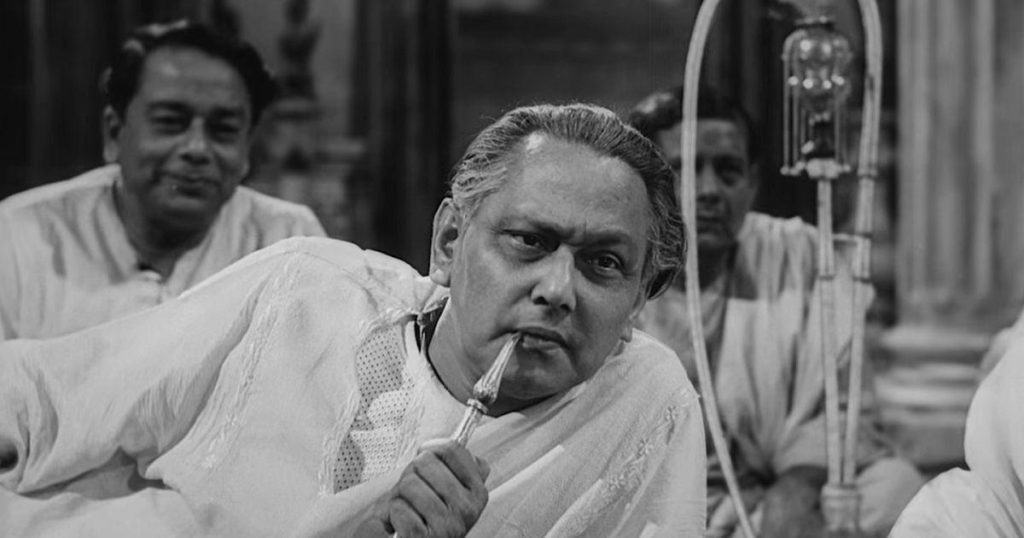Astonishingly, folded in between the films that comprise the celebrated Apu Trilogy, are two movies inspired by Bengali literature and Satyajit Ray’s association with two outstanding Bengali character actors: Tulsi Chakraborty in Parash Pathar and Chhabi Biswas in Jalsaghar. The first is perhaps minor (in spite of Chakraborty’s phenomenal performance) and is now mostly forgotten. However the latter is among the three or four greatest films in Ray’s oeuvre, and Chhabi Biswas’s performance is unsurpassed in his own illustrious career.
Elegiac in tone, Jalsaghar (The Music Room) is, to quote John Russell Taylor, “an atmospheric piece”. It occasionally reminds one of Orson Welles’s The Magnificent Ambersons, which was about the decline of a wealthy American Midwestern family in the late nineteenth century. The swansong of a stubborn and self-absorbed zamindar, Jalsaghar depicts the passing of the old feudal social order in early twentieth-century rural Bengal giving way to another that is bourgeois and perhaps coarser but more in tune with the future.
Chhabi Biswas plays the zamindar Biswambhar Roy who, at the beginning of the film, is already out of touch with reality and sunk in sorrow for his dead wife and only son. Rivalry with his nouveau riche neighbour Mahim Ganguly (Gangapada Bose) spurs him to reopen his music room and host a lavish and showy jalsa, or musical soiree, to indulge his passion for music, which has already ruined him along with his refusal to adapt to the changed social and economic realities. At the end of the concert, Biswambhar upstages his rival with a grand gesture, restraining Mahim’s attempt to reward the kathak dancer with his last bag of gold coins.
After that, he spends the rest of the night drinking in the music room beneath the portraits of ancestors and his own recently added one. He raises a toast to his ancestors whose blood (“Rakto! Rakto!” The blood in my veins, he exults) and lineage he is so immensely proud of. He then mounts his white stallion Toofan and rides to his death against the prow of a boat moored by the dry river bank.
Ray’s attitude towards Biswambhar Roy’s madness has been aptly compared to that of Shakespeare towards King Lear – a combination of pity and compassion that is nevertheless a censure of his folly.
Jalsaghar has, as many commentators have noted, one of the finest opening flashback sequences in the history of cinema. The credits appear over the shimmering chandelier in the music room that is otherwise in shadow. A crescendo of ominous music leads us to a close up of Biswambhar’s immobile face. It is morning, and he has settled in his chair on a terrace overlooking the riverbank, waited on by his loyal manservant (played by Kali Sarkar in one of the film’s several memorable cameos). As haunting shehnai music (played by Ustad Bismillah Khan) wafts across from Mahim’s house where a concert is being held, he begins to reminisce about his own glory days.
The motif of shehnai music continues as we are introduced to his devoted wife and a handsome young son whose thread ceremony is being celebrated, which will climax with another grand concert in his music room in the evening. Interaction with his wife and steward make it clear that Biswambhar has already spent much of his fortune on extravagant concerts. His false pride and arrogance blinds him from exercising the flexibility required to manage his estate profitably. These deep-rooted flaws in his character prove to be his inevitable undoing.
A little later, after he consents to his wife and son travelling by boat to her native village, Biswambhar responds to an invitation to attend Mahim’s house-warming concert with a concert of his own. It is held during a stormy night. Biswambhar’s imminent doom is shown by Ray in a succession of symbolic images: the overturning of a miniature ivory boat that anticipates the death by drowning of his wife and son, the ill-omened cockroach that swims in his whisky glass, and, most powerfully, in the flickering of the lamps in the swaying grand chandelier.
This is perhaps excessive for modern-day taste, but Ray pulls it off by making each of these images integral to his magisterial mise-en scene, infusing them with an intrinsic or organic quality that is true to the flow of the narrative.
Another symbolic image occurs at the end of the flashback in the unforgettable shot of a truck trundling along an old country road towards Mahim’s house as Biswambhar’s elephant Moti grazes by the river bank. The onset of the new machine-dominated age represented by the truck is contrasted with the slow-moving and graceful elephant that stands for the fading or obsolete way of life that the zamindar obstinately upholds.
To focus only on the chandelier (a prime status symbol of Indian royalty and landed aristocracy borrowed from the British), its meaning morphs with each of its subsequent appearances. It is luminous and in full glory in the first music sequence of the flashback, casting its luxuriant light on both performers and listeners. It is seen again in the second music concert during the storm with its wavering lamps foretelling the capsizing of the boat that is bringing home his wife and son.
The chandelier then appears prominently in the closing sequences when, instigated by Mahim’s invitation to the inaugural concert at his new house, Biswambhar decides to end his mourning and reopen the music room. Against the advice of his steward, he removes the last bag of gold coins from the safety box to pay for the services of a kathak dancer who is the new rage among music connoisseurs.
The loyal manservant joyfully sets about cleaning, burnishing and lighting the chandelier as the music room is prepared with the unrolling of carpets and the pouring of liquor into crystal decanters. After the performance Biswambhar swaggers drunkenly among the family portraits in the music room. His certain fall is reflected in the sputtering lamps, which blow out one by one like the hero’s own life breath. So rich is the symbolism of the chandelier that Jalsaghar’s story could be told by merely singling out this motif throughout the film.
I conclude with a few remarks on the three musical soirees, which are a precious historical record of some of the great performing artists of the 1950s. In the first, there is the incandescent presence of Begum Akhtar singing an exquisite thumri, which brims with ache and longing for the beloved.
The second soiree during the fateful night of the storm features a magnificent khayal composition by an old ustad (whose identity I have not been able to establish). His darting eyes set in a wizened and bearded face seem to warn Biswambhar of the tragedy that is to befall him very soon.
The final concert in the reopened music room showcases a hypnotic kathak dance by Roshan Kumari, whose dazzling footwork Biswambhar rewards with his last bag of gold sovereigns. And for the background music score, Ray enlisted the talents of Ustad Vilayat Khan, whose melodious sitar solos embellish the most lyrical moments in the film.
Each of these musical sequences not only appropriately reflects on the unfolding narrative, but also transports one to the realm of ananda, or pure bliss, that Indian music lovers aspire to. One is almost tempted to forgive the blindness and self-indulgence of the foolish landlord, for these moments of heightened aesthetic delight are a direct consequence of his extravagant patronage.
To my mind, they raise Jalsaghar to the ranks of the handful of films that have successfully expressed India’s performing arts with the full force of artistic revelation. Only a couple of films by Mani Kaul (Dhrupad and Siddeshwari, for instance), Kumar Shahani’s Khayal Gatha and the mujra sequence in Abrar Alvi’s Sahib Bibi aur Ghulam have the same elan that Satyajit Ray captures in Jalsaghar.
(Courtesy: Scroll.in.)




